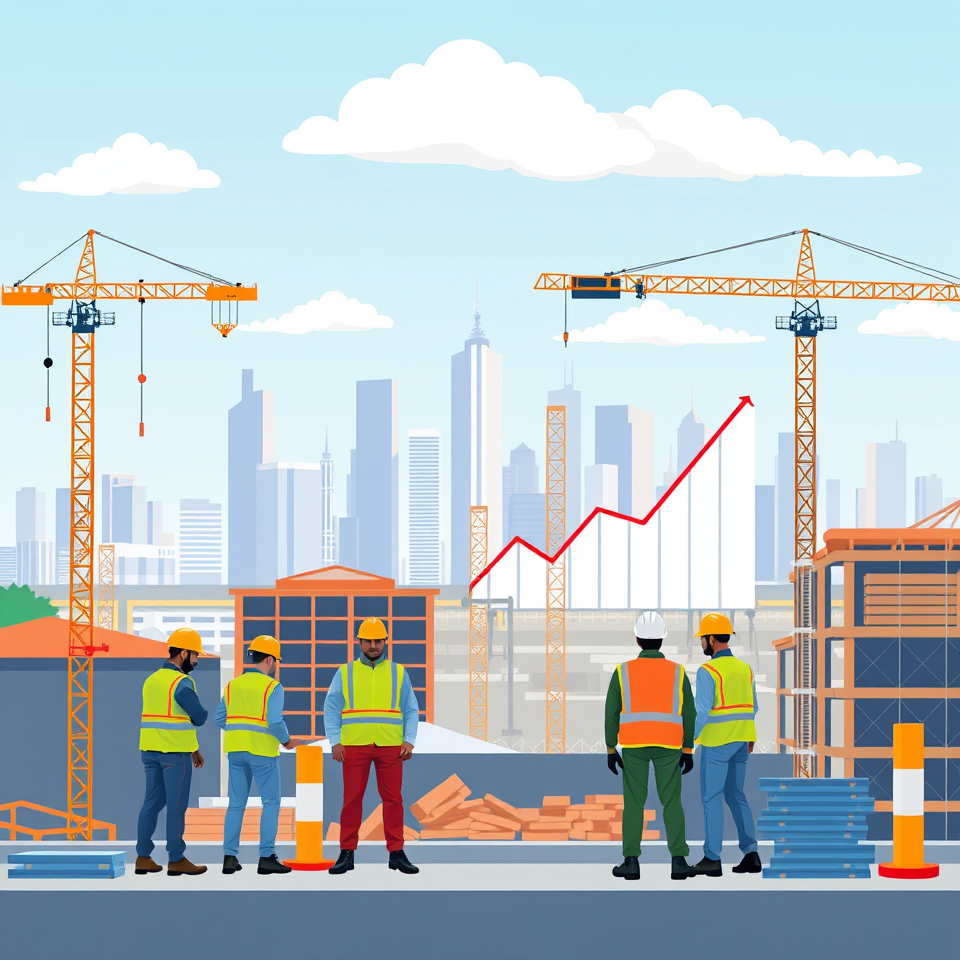Introduction
As Canada enters 2025, construction costs remain a central concern for developers, investors, and lenders alike. After years of intense volatility driven by the pandemic, supply chain disruptions, and inflationary spikes, the industry is now experiencing a period of relative stabilization. However, this doesn’t mean the challenges are over.
Labour shortages, new regulations, and tariff risks continue to shape the cost environment in complex ways. Understanding the latest trends in Canada’s construction costs—across both residential and non-residential sectors—is essential for planning, underwriting, and executing successful real estate projects in today’s cautious but opportunity-rich market.
National Overview: Construction Cost Trends in Q4 2024

Construction costs across Canada continued to rise in Q4 2024, albeit at a slower pace compared to post-pandemic highs. Both residential and non-residential sectors recorded similar quarterly increases of 0.8%, signaling persistent—yet stabilizing—pressures on project budgets and financing needs. Read our exclusive report!
Slowing Momentum But Ongoing Cost Pressures
Residential Sector
Residential construction costs rose by 0.8% in Q4, following a 0.9% increase in Q3. Despite a moderation in growth, the rate remains elevated compared to pre-pandemic levels.
Non-Residential Sector
Non-residential construction matched the 0.8% rise, up from 0.6% in Q3. Year-over-year, construction costs climbed by 3.7% for residential buildings and 3.8% for non-residential buildings across Canada’s 15 largest Census Metropolitan Areas (CMAs).
Structural Cost Drivers
Key long-term cost pressures include:
-
Skilled labor shortages and wage inflation
-
Updated building codes and regulatory compliance
-
Limited urban land supply in high-demand regions
These factors are reshaping financial strategies for both developers and lenders.
Regional Insights: Variations Across Canada
Residential Sector Highlights
-
Regina saw the largest Q4 increase at 2.5%, followed by Calgary at 1.8%.
-
Vancouver posted the smallest rise at just 0.2%.
-
Major cost drivers: general requirements (+1.6%), interior finishes (+1.5%).
Non-Residential Sector Highlights
-
Toronto led with a 1.1% rise.
-
Québec City followed with 0.9%, while Calgary saw no change.
-
Inflated components: Conveying equipment (+2.4%) and electrical systems (+1.3%).
These regional dynamics guide investor and lender risk assessments.
Quarterly Construction Cost Comparison
| Category | Q4 2024 Change | Q3 2024 Change | Year-over-Year |
|---|---|---|---|
| Residential Construction | +0.8% | +0.9% | +3.7% |
| Non-Residential Construction | +0.8% | +0.6% | +3.8% |
Source: Statistics Canada
A Market at the Crossroads: Stabilization Ahead?
In 2025, the Canadian construction sector is entering a phase of cost stabilization. The extreme volatility of 2021–2023, driven by global supply chain breakdowns and inflation, is giving way to a calmer environment. Most material prices now show year-over-year changes of just 0–3%.
Market-Wide Influences
1. From Surges to Stability
Costs for concrete, steel, and mechanical components have normalized, allowing more reliable budgeting.
2. Tariff Uncertainty Returns
With 8.1% of inputs imported from the U.S., tariff risks remain—especially for steel and specialty materials.
3. Labour and Regulation Pressures
Skilled labour shortages and updated building codes (e.g. climate resilience standards) continue to drive costs.
Regional Construction Trends – 2025
| Region | Trend | Key Influences | Viability Outlook |
|---|---|---|---|
| Vancouver | ↑ Slight Rise | Labour rates, stricter envelope standards | Transit-oriented mid-rise most viable |
| Montreal | ↑ Rising | Union wage increases, strong industrial demand | Suburban rentals remain feasible |
| Calgary/Edmonton | ↑ Rising | Labour shortages, infrastructure boom | Office-to-residential conversions growing |
| Toronto | ↓ Slight Fall | Demand softening, more contractor availability | Rental incentives enhance feasibility |
Source: Altus Group
The Tariff Effect on Canadian Real Estate

Currency Volatility
-
Tariffs weaken the Canadian dollar
-
Imported materials cost more, squeezing budgets
-
U.S. investors benefit from favourable exchange rates
Industrial Sector Vulnerability
-
Cost pressures challenge tenant margins
-
Rent concessions or slower leasing activity may emerge
Interest Rate Uncertainty
-
Tariff-driven inflation complicates central bank decisions
-
Lenders react by tightening underwriting conditions
Geographic Impact
-
Manufacturing-heavy areas like Windsor are more exposed
-
Tech-driven markets show more resilience
How Smart Capital Can Help Navigate the Uncertainty
At Smart Capital, we help clients:
Assess Feasibility
-
Analyze cost projections and material sensitivity
-
Identify risk factors related to tariffs and interest rates
Secure Tailored Financing
Leverage Lender Networks
-
Strong ties with banks, credit unions, and private lenders
-
Ability to negotiate competitive terms
Proactively Engage Lenders
-
Early involvement to avoid delays
-
Scenario modeling and risk-mitigation planning
Frequently Asked Questions
Why are construction costs still rising in 2025?
Labour shortages and regulatory changes are the primary drivers—even though material prices have stabilized.
How do U.S. tariffs affect project budgets?
They raise the cost of imported materials and complicate procurement strategies.
Which Canadian cities offer better development feasibility?
Toronto and Ottawa, where demand has softened and incentives exist, are currently more favourable.
What sectors are most exposed to cost volatility?
Industrial, high-rise residential, and infrastructure projects—due to high material and labour demands.
How does Smart Capital support developers?
We provide custom financing, risk mitigation, and underwriting support to align funding with market conditions.
Conclusion: Planning Ahead in a Stabilizing Market
While Canadian construction costs are no longer spiraling, persistent headwinds—from labour to regulations to tariff impacts—mean smart planning remains essential.
Partnering with experts like Smart Capital ensures access to:
-
Predictable financing
-
Strategic cost modeling
-
Resilient capital structures
Ready to Navigate Cost Volatility with Confidence?
Book a free consultation with one of our commercial real estate financing specialists. We’ll help assess your project’s feasibility, identify the best funding options, and structure a capital stack that aligns with your timeline and budget.
👉 Schedule Your Free Consultation Now


